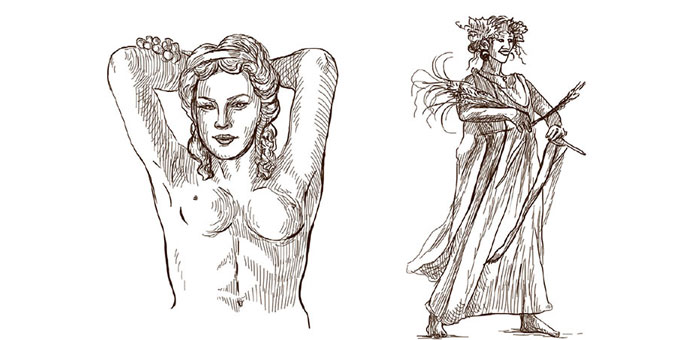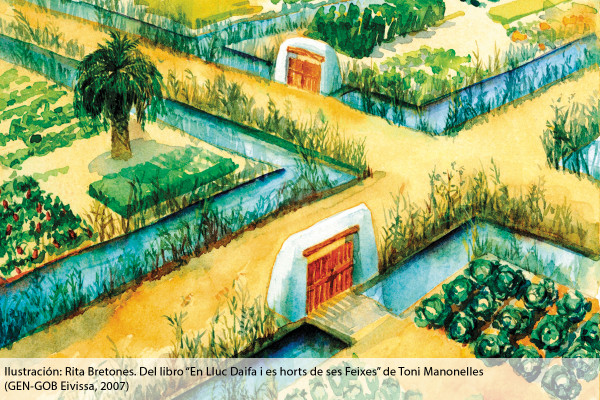I want to receive new articles by email
Ibiza’s History - Part III: The Goddesses of Ancient Ibiza
By Emily Kaufman
Religion was a cornerstone of the ancient world. To understand history in all its nuanced complexity, we must contemplate not only the outer events of wars and statecraft, but also the spiritual underpinnings that stirred and sustained early societies. Ibiza, as evidenced by abundant material remains, developed an exceptionally strong religious component, especially during pre-Roman Antiquity. The gods and goddesses that comprised its pantheon – eight in total – are not as familiar to us by name as their Greco-Roman counterparts; yet, the themes they encompassed drew deeply from the same cultural matrix in which all Mediterranean deities were cast. In the early 20th century, archaeological excavations of island sanctuaries, especially es Culleram (near San Vicente) and Illa Plana (near Botafoc), began to shed light on these mythical figures, sparking a growing fascination… especially in regard to Ibiza’s chief goddess Tanit.

The deities venerated in Ibiza (except for one) originated in Phoenicia, and were brought westward in the course of trade and colonization. Hence, by the end of the 7th century BCE (2,600 years ago), the complexities of Phoenician polytheism had begun to replace the Bronze Age nature worship that had previously been practiced by the island’s native inhabitants. Before we meet the island’s three goddesses individually, let us consider a few fundamentals of the Phoenician cosmology. Canaanite religion was presided over by a dual godhead, consisting of both a male and a female deity. The male deity was perceived as an aloof figure who, in the distant past had set the world in motion. He then receded to a passive realm, leaving the female deity as the primary object of worship and supplication. Within this basic framework, Phoenician religion was practiced throughout its far-flung territories, with its malleable nature conforming to the specific mores of each city-state or colony. In the case of Ibiza, island practices were originally modelled on those of Phoenicia, and later on those of Carthage - although its own set of core local values always prevailed.

The first female deity of which there is archaeological evidence in Ibiza is Astarte, a very ancient Semitic Nature Goddess. She presided as the supreme female deity in Phoenicia, having emerged from the Babylonian Ishtar and the Egyptian Isis, and later evolving into the Greek Aphrodite and the Roman Venus. As with a great many other fertility goddesses, sacred marriage and ceremonial sex were practiced in Astarte’s name. To the ancient mind maintaining the earth’s fertility was a matter of survival, and it entailed a prescribed set of religious observances - among them the mating of exalted personages such as kings with high priestesses. It was believed that these ritualized acts would call down the divine spirit, making the fields fruitful and the herds productive. This type of magical fertility rite was a common thread that ran through many cultures, though there is no proof that they were practiced in Ibiza. The supposition that they were not rests on the dearth of terra-cottas ascribed to Astarte in the archaeological excavations of Illa Plana and es Culleram, in contrast to the profusion of votive figures attributed to Tanit.

In all probability, during the island’s early Phoenician period – when Astarte held sway – Ibiza would have been too poor and bereft of inhabitants to sustain an exalted priestly class or stage elaborate rites. Mortality statistics gleaned from the Puig des Molins necropolis during this period (625 to 450 BCE) indicate that the population was only about 400 - 500. By the time local Punic culture had reached its high point (450 – 325 BCE) - with a robust population exceeding 5,000 - Astarte was no longer being worshipped in the western Mediterranean. Tanit had arrived… blithely replacing her as the Great Mother Goddess and chief deity of Ibiza.
Tanit was a fertility goddess, but therein ends her similarity to Astarte. For Tanit was not envisioned as a goddess of love and sexuality, but rather as a stately embodiment of empire, having been deliberately adopted by Carthage as a symbol of their political independence. In 480 BCE, Carthage terminated the payment of tribute to Tyre, establishing itself as the pre-eminent sea power of the western Mediterranean. It also became the main granary of its geopolitical sphere of influence by cultivating large swaths of territory in the North African hinterland. For this new undertaking Carthage needed a new agrarian goddess who would watch over the fields, regulate the weather and ensure abundant harvests.

Rather than advocate these outcomes through old Levantine sex rites, they opted for Tanit, a virginal herald of spring who had been a lesser deity in the Phoenician city-state of Sidon. Carthage brought her west and elevated her to Great Mother status. In Ibiza, a devoted cult quickly grew up around Tanit, who for centuries was honoured with a great festival every year at es Culleram sanctuary. These rites celebrated the return of fertility to the fields in late February or early March. A high priest officiated as local farmers made offerings of livestock and other produce. Goats and lambs were ritually sacrificed, incense was burned and, after the proper libations were made, the meat was roasted for a communal feast. Other offerings included milk, honey, bread, oil, fruit, etc., which were set out amid music and dancing.
Above and beyond her agrarian function, Tanit was venerated as an all-encompassing Great Mother Goddess with stewardship over fertility, augury and warfare. She ruled over the three realms of existence: the heavens, the earth and the underworld. Conceived as a virginal mother whose ever-flowing milk nourished and replenished the land, she is clearly differentiated from the carnal potency of Astarte. This distinction is borne out historically by the fact that Astarte evolved into the goddesses of love Aphrodite and Venus, whereas Tanit became identified with Juno, Queen of the Heavens and consort to top god Jupiter.

One question that may be troubling some readers is the subject of child sacrifice, which is known to have been enacted in Tanit’s name in several centres of devotion, notably Carthage and Sardinia. While much could be said on the topic, we will limit our commentary to a single fact: it was not done in Ibiza. This consensus was arrived at by the directive body of Ibiza’s Archaeology Museum after years of thorough scientific analysis of all island excavations, especially its main necropolis. No evidence supports the practice, while abundant indications argue against it.
Moving on to the third of the female deities worshipped in ancient Ibiza, we find the Greek Goddess Demeter who was brought to the island via Carthage. As a goddess of fertility, agriculture and marriage, she bears a broad resemblance to Tanit, but they are archaeologically distinguished. Demeter was later assimilated into the Roman system as Ceres.
That wraps up our look at the Goddesses of Ancient Ibiza. Please join us next time when we will turn our attention to the island’s male deities.











